Abstract
Non-invasive techniques are being increasingly used for the study of heritage objects. This article describes the results of pigment analysis on a fragmentary Egyptian sculpture using two non-invasive infrared methods: external reflectance Fourier-transform infrared (ER-FTIR) spectroscopy and visible-induced infrared luminescence (VIL) photography. ER-FTIR spectroscopy was used to identify certain of the pigments used on the sculpture, including Egyptian blue, in variously coloured areas. An optimized VIL photographic technique, using a high-resolution camera combined with focus-stacking, permitted detailed mapping of the location of Egyptian blue on the sculpture, including sub-millimeter grains of the pigment scattered across the object’s surface, which were not visible to the naked eye.
1. Introduction
In the context of a larger study of Egyptian artefacts undertaken by the Canadian Conservation Institute (CCI), the pigments on a fragmentary Egyptian sculpture were analyzed using two non-invasive methods: external reflectance Fourier transform infrared (ER-FTIR) spectroscopy and visible-induced infrared luminescence (VIL) photography. The ER-FTIR method was used to identify some of the pigments used on the sculpture, including Egyptian blue. The distribution of the Egyptian blue was subsequently mapped with an optimized VIL photographic method. The results provided new information about the materials of the polychrome surface of the sculpture; in particular, the use and distribution of Egyptian blue pigment.
The object examined in this case study is a small, fragmentary Egyptian head from the collections of the Canadian Museum of History in Gatineau, Canada. Little is known about this sculpture. At the time of its acquisition in 1973 by former museum director George McDonald, its fabrication date was estimated at 600–300 BCE [1], likely placing it within the Late Period (26th–31st Dynasty) or the early Greco-Roman period. The object is composed of several pieces of wood, with visible joints and dowels. It is decorated with black, red, blue, yellow and pink paint over a white preparation layer. The paint surface is worn, with many areas of bare, exposed wood. The proper left side of the hair piece and the tip of the nose are missing. No conservation treatments have been recorded [1].
In recent years, there has been an increasing focus on the use of non-contact and non-destructive techniques for the study of cultural heritage [2,3,4,5,6]. VIL photography and ER-FTIR spectroscopy are both important techniques in this area.
Though portable FTIR instruments have long shown great potential as a non-invasive tool for the analysis of cultural heritage [3,7,8,9], the challenges of spectral interpretation in reflection configurations, as compared to more established infrared spectroscopy methods, have likely slowed its wider adoption within heritage institutions.
Many newer external reflectance accessories have been designed primarily to measure smooth, glossy surfaces in specular reflection. The derivative-like features typically obtained can then be transformed using a Kramers–Kronig transformation (KKT) to obtain a spectrum that more closely resembles a traditional transmission spectrum. While this often works well for organic materials such as hard plastics [10,11], and glossy varnishes [12], painted surfaces—often textured or matte, and containing both organic and inorganic components—rarely approach this ideal. Several distortions typically come into play, which greatly complicate spectral interpretation, and limit the usefulness of KKT.
ER-FTIR spectra include both specular (surface) and diffuse (volume) components, with a ratio that is dependent on surface roughness. For smooth surfaces, specular reflection may dominate the spectrum, whereas on matte surfaces, diffuse reflection may be of greater importance. However, both phenomena exist to varying degrees, adding complexity to spectral interpretation. Organic polymers often display derivative-shaped peaks, whereas inverted (restsrahlen) bands appear for many inorganic salts. Normally weak overtone and combination bands are often amplified in diffuse reflectance, becoming key diagnostic features [13,14]. The analysis depth also depends on several factors, including wavelength, surface gloss and texture, and the characteristics of the sample including the absorption and refractive indexes [14]. The variability of spectra creates challenges in interpretation, as well as in building useful reference databases, such as those that exist for transmission and attenuated total reflectance (ATR) spectra.
The external reflectance accessory for the Bruker Alpha also includes aperture spacers, which can be used to narrow the analysis window to 3 mm or 5 mm. However, where non-contact analysis is required, the aperture spacer must be removed, which gives an analysis area closer to 1 cm in diameter, thus limiting one’s ability to pinpoint small colour areas for analysis.
Despite these challenges, several pigments frequently found on Egyptian artefacts [15,16,17,18], including calcite, gypsum, and Egyptian blue, were identified on the fragmentary sculpture using this technique.
Egyptian blue was the primary blue pigment used in Ancient Egypt. Thought to be the first synthetic pigment, Egyptian blue was first produced around the 4th Dynasty and was in common use until the end of the Roman period [19]. The main component of Egyptian blue is a calcium copper silicate—the synthetic equivalent of the rare mineral cuprorivaite (CaCuSi4O10). The pigment was made by heating together three components: silica (e.g., quartz-rich sand), calcium (e.g., calcium carbonate), and a source of copper, (e.g., metal filings or copper ores) at high temperature, to create a blue frit. An excess of quartz was typically used [19,20,21].
The unique visible-induced infrared luminescence of Egyptian blue was first reported in 1996 [22]. The exceptionally strong luminescence of Egyptian blue is due to d-d electronic transitions, related to the Cu2+ ion and surrounding cuprorivaite crystal structure. There is a broad absorption peak centered around 637 nm and extending across most of the visible range, and an emission peak with a maximum at 910 nm in the near infrared (NIR) [23,24]. The structurally related pigments, Han blue (BaCuSi4O10) and Han Purple (BaCuSi2O6), also demonstrate strong luminescence [23,24]. The imaging of Egyptian blue using VIL was developed by Verri in 2016 [25,26]. Since then, several case studies have been published that illustrate the identification and mapping of Egyptian blue on heritage objects using VIL imaging [27,28,29,30,31,32]. This technique allows mapping of Egyptian blue, even when it is not readily visible on the object due to surface patinas or coatings, or because most of the pigment has worn away. Some studies have also recorded differences in VIL correlated with differences in production technologies [21,33]. More recent developments in VIL imaging include the use of Raman microscopy to map VIL at a micron scale [34], and the combination of VIL imaging with photogrammetry, to create 3D models of Egyptian blue distribution on sculptures [35].
The VIL photographic method used in this case study is based on previously published methods [25,26,36]; however, the methodology has been optimized with the use of a high-resolution camera combined with focus stacking. Using this improved method, detailed images from centimeter-sized areas of the sculpture were obtained from a single, overall VIL photograph: this allowed non-invasive mapping of individual, sub-millimeter grains of Egyptian blue. The location of the Egyptian blue particles in the VIL photographic details were correlated with photomicrographs of the sculpture.
2. Materials and Methods
2.1. FTIR Spectroscopy
For non-invasive analysis by FTIR spectroscopy, the sculpture was analyzed using a Bruker Alpha spectrometer with an external reflection sampling module, mounted on a tripod. The Alpha-R A241/DV module, which has an integrated camera to assist with positioning, was employed. Spectra were collected using OPUS v7.5 software and were recorded in the range of 6000–400 cm−1 with a spectral resolution of 4 cm−1 and 64 scans. For non-contact analysis, this module was used without an aperture spacer. This gives an analysis area of approximately 1 cm in diameter. Many of the coloured areas on the sculpture are very small and were difficult to pinpoint precisely using non-contact ER-FTIR, due to the limited spatial resolution of the instrument.
A small sample was taken from an abraded blue area, to confirm the presence of Egyptian blue. The sample was analyzed by μFTIR spectroscopy using a Bruker Hyperion 2000 microscope with MCT-B detector interfaced to a Tensor 27 spectrometer (Bruker corporation, Billerica MA, USA). A portion of the sample was positioned on a diamond microsample cell and analyzed in transmission mode. Spectra were collected using OPUS v7.5 software and were recorded in the range of 4000–400 cm−1 with a spectral resolution of 4 cm−1 and 64 scans. Results were compared to known reference samples and reference libraries.
2.2. Optical Microscopy
Photomicrographs of the surface of the sculpture were captured with a Leica 205C microscope interfaced to a DMC 5400 digital camera (Opti-Tech Scientific Inc., Whitby, ON, Canada). Image capture and processing was undertaken using Leica LAS X software (version 3.0.12.21488) and its automated z-stacking function. This uses system-optimized acquisition increments to create an image with an extended depth of field.
2.3. Imaging Techniques
2.3.1. Set-Up
Visible (VIS) and visible-induced infrared luminescence (VIL) imaging were performed using a Phase One XF IQ4 150 mp camera system (PhaseOne, Frederiksberg, Denmark) equipped with a Phase One Schneider Kreuznach LS 120 mm f/4.0 lens. The image sensor has been modified by removing the UV/IR bandpass filter, allowing for a broader range of spectral imaging.
Tethered image capture was performed using Capture One Pro 22. Due to its ability to be viewed on a large computer monitor, the Capture One Live View mode was used for composing and focusing the image, allowing for precise adjustments. The camera was tethered to the computer system using a USB cord and the images imported live in Capture One. Tethered shooting allowed for long exposures to be obtained without camera movement, producing sharp images.
The camera system was mounted to a large copy-stand and the sculpture was placed on a black background below it, as shown in Figure 1. The same light sources were used for both the VIS and VIL imaging. The sculpture was illuminated using two LED panels, LEDGO LG-1200s, which produce a soft light that projects evenly across a surface. As shown in Figure 2, there is a peak emission between 400 and 500 nm and moderate emission between 500 and 700 nm, which makes this light suitable for stimulating infrared luminescence of Egyptian blue. The LED panels do not emit any infrared radiation, which would otherwise contaminate the VIL image, nor do they emit any UV radiation, making them less likely to cause damage to the object over long exposures.
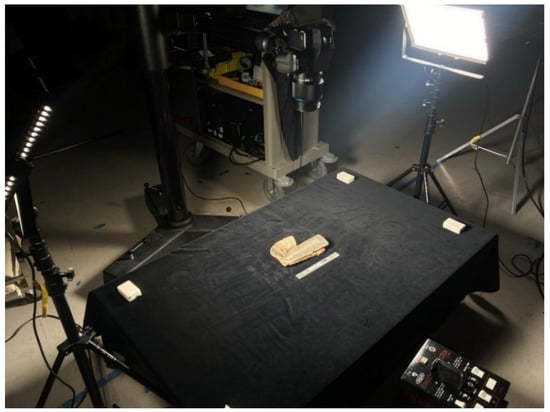
Figure 1.
Studio setup for VIS and VIL image acquisition of the fragmentary Egyptian head.
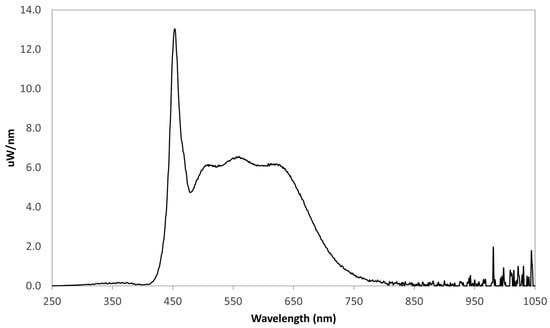
Figure 2.
Spectral emission curve of the LEDGO LG-1200s LED panel, as measured at CCI (Adapted with permission from ref. [37].
Each light was positioned on opposite sides of the sculpture, providing even illumination. The lights were placed at a 45° angle to the surface of the sculpture and the power outputs were set to the highest settings. A Sekonic L-478DR Lite Master Pro incident light meter was used to establish an even illumination of the object and to determine the overall light intensity. The four corners of the object and the centre were measured, and a reading of f11 ± 0.2 was achieved by adjusting the barn doors and slightly turning the lights. The overhead fluorescent lights in the imaging studio were turned off during all exposures to avoid contaminating both the visible light and VIL imaging.
2.3.2. Visible Light (VIS) Imaging
Visible light imaging was performed as a general method of documentation of the sculpture in the visible spectrum. It is an important tool used to better understand the general distribution of pigments and aid in the interpretation of the VIL image, which is not always clear on its own.
Imaging in the visible spectrum was executed by mounting an IR/UV bandpass filter to the lens, which blocked any IR or UV light from reaching the sensor. An exposure of f11, 1/13 s, and 50 ISO produced an image with proper tonal reproduction. Settings are summarized in Table 1.

Table 1.
Summary of equipment and exposure settings.
A Lens Cast Calibration (LCC) was performed using a Phase One LCC plate and the LCC tool in Capture One Pro 22. This process corrected for lens vignetting and allowed for flat fielding to be achieved.
An X-Rite ColorChecker® Digital SG target was photographed to establish an accurate colour balance and to verify even exposure across the image surface. An object level target (Image Science Associates Golden Thread) was also included in each image, to verify consistent exposure and colour balance from image to image, as well as to evaluated the overall optical resolution using the hyperbolic wedge chart.
2.3.3. Visible-induced Infrared Luminescence (VIL) Imaging
For the visible-induced infrared luminescence (VIL) imaging, the lens was equipped with a Kodak Wratten 87C filter (790–940 nm). An exposure of f11, 1/60 s, and 400 ISO produced an image with sufficient tonality, allowing the viewer to examine the details of the bright luminescent regions while still distinguishing the darker regions of the object. Settings are summarized in Table 1.
An ISO of 400 allowed for a reasonably fast shutter speed to be used, reducing the chance of camera shake. It also allowed for a smaller lens aperture to be used, therefore reducing the number of images needed in the focus stack.
An LCC was not performed, because the process for creating the LCC image could not be completed using the chosen VIL setup.
The X-Rite ColorChecker® Digital SG target was not photographed in VIL as there is no colour information recorded in the IR range. An object level target (Image Science Associates Golden Thread) was included in each image, to verify consistent exposure from image to image, as well as to evaluate the overall optical resolution using the hyperbolic wedge chart.
2.3.4. Focus Stacking
To maximize the optical sharpness and depth of field for this three-dimensional object, it was photographed using focus stacking; this is a computational imaging method which combines multiple images taken at different focal distances. Adjustments to the focus were carried out with the UV/IR bandpass filter mounted to the front of the lens. Using the Focus Stacking tool, built into the Phase One XF body, the near focal point and far focal point of the sculpture were preprogrammed, and the number of captures was calculated by the camera system. The object was photographed at 19 different focal points for the VIS images and 20 different points for the VIL images. For the latter, the focus range was extended to allow for the shift in focus from the visible spectrum to the near-infrared spectrum.
2.3.5. Image Processing
Image processing was performed using Capture One Pro 22. There were no adjustments made to the individual VIS images, except for colour-balancing and the application of the LCC. No adjustments were made to the final stacked image.
Several adjustments were made to the individually captured VIL images and the final stacked image. Prior to focus stacking, the images were converted to grayscale using the Black and White tool and the exposure was adjusted to brighten the darker areas of the object. After focus stacking, further adjustments were made using the Curves, Exposure, High Dynamic Range, and Clarity tools.
The focus stack image assembly was performed using Helicon Focus software version 7.6.6. The images were imported directly from Capture One and were subsequently stacked using Method B (depth map) rendering with a radius of 8 and a smoothing of 1. The software assembled the stack perfectly and further retouching was not needed. The stacked images were exported at uncompressed 16-bit TIFF files with an Adobe RGB (1998) colour profile.
3. Results
3.1. Analysis
All colour areas on the object were analyzed non-invasively using ER-FTIR spectroscopy. The results are summarized in Table 2. Binding media were not identified. Spectra are provided as supplementary material in JCAMP-dx format (Figure S1).

Table 2.
Summary of the results of ER-FTIR analyses.
Calcite and gypsum were readily identified by ER-FTIR spectroscopy using characteristic overtone and combination bands, which are enhanced in the reflectance spectra [13,14]. Calcite was identified in all colour areas analyzed, from the presence of combination bands at 2517, 2593 (shoulder) and 1795 (inverted) cm−1, and an overtone band around 4266 cm−1 [14]. In some cases, fundamental bands at 876 and 712 cm−1 were also visible, though in others they were distorted or overlapped with other spectral bands, limiting their usefulness in pigment identification. Calcite was the primary white pigment identified on the object and appears to have been used in mixtures, such as to create the shade of pink used on the headpiece. In other cases, coloured paints were thinly applied over a white paint layer—such as a thin wash of black paint used to create a shade of grey. In these cases, the calcite detected likely originates in the white layer below. Gypsum, characterized by overtone and combination bands at 5141, 2232 and a doublet at 2132 and 2114 cm−1 [13], was only detected in one area—the off-white ground layer. An inverted band at 670 cm−1 is also visible, though most other fundamental bands characteristic of gypsum were not clearly visible in ER-FTIR spectra. In red, yellow and pink areas, kaolin was identified by distorted and inverted fundamental Si-O stretching vibrations at 1117, 1030 and 1107 cm−1, a weak OH stretch at 3697 cm−1, as well as weak oxide bands centered at around 524, 468 and 423 cm−1. Other white pigments, such as the magnesium calcium carbonate, huntite (Mg3Ca(CO3)4), are frequently found on Egyptian objects [16,38], including by the authors [39], but were not identified on this fragmentary head.
Egyptian blue and quartz were identified on the sculpture using ER-FTIR spectroscopy, in blue areas on the figure’s temples (Figure 3). Reference spectra for cuprorivaite [40,41,42] show distinct bands in the Si-O region that are also visible in reflection mode and can be used for its identification. Inverted bands present at 1220, 1180, 1076 and 1006 cm−1 correspond roughly to bands at 1252 (shoulder), 1163, 1060, and 1007 cm−1 in transmission reference spectra. There are also inverted bands in the lower wavenumber region at 528, 486 and 427 cm−1. Bands for cuprorivaite and quartz overlap in these regions, and so the position of the bands is also influenced by the presence (and relative amount) of quartz in the mixture. An inverted peak at 664 cm−1, corresponding to a peak at 667 cm−1 in the transmission spectrum for Egyptian blue, is also present, as is a small, inverted doublet, characteristic of quartz (797, 780 cm−1). Egyptian blue can also be recognized by the presence of a characteristic stairstep pattern of Si-O (ν + δ) combination bands between 1800 and 2400 cm−1 [14].
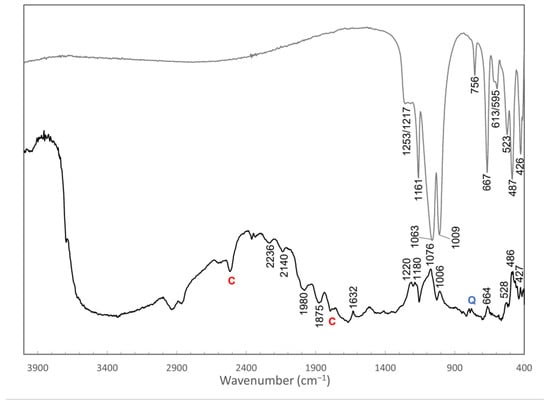
Figure 3.
Comparison between an ER-FTIR spectrum taken from a blue area of the object (lower trace) and a reference sample of Egyptian blue (sample is from the Forbes collection of pigments, 8.01.2a, made by LeFranc). Peaks for calcite noted with a C, peaks for quartz noted with a Q.
The surface of the blue areas on the sculpture were yellowed, giving the areas a greenish cast. The discoloration appeared to be a surface crust linked to a discoloration of the binding medium or a surface coating, rather than a change in the pigment itself. Brighter blue particles were visible in an abraded area, as shown in Figure 4. Examining this area of Egyptian blue under a high-power microscope revealed a mixture of coarse particles, ranging from vibrant rich blue to nearly colourless.
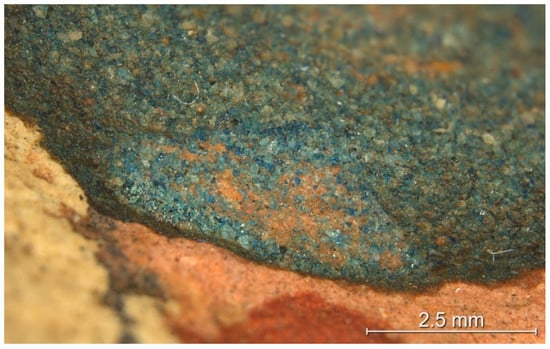
Figure 4.
Detail from the blue area on the figure’s proper right temple, captured with a Leica 205C microscope and LAS X software.
Two particles were removed from this area for analysis by μFTIR spectroscopy. While the deeper blue particle contained primarily peaks for Egyptian blue (cuprorivaite), substantial peaks corresponding to quartz, including the characteristic doublet (799/780 cm−1) were also present. Conversely, the pale blue particle showed primarily strong peaks corresponding to quartz, with only small peaks attributable to cuprorivaite. The spectra are included as supporting information (Figure S1).
3.2. Imaging
VIL was used to map the areas of Egyptian blue on the sculpture. The optimized method employing a high-resolution 150 mega pixel camera and focus stacking allowed for extremely fine details with good depth of field to be captured in the VIL photograph. As seen in Figure 5b, the shadowed regions of the VIL image were brightened so that the overall shape and tonality of the sculpture are visible. The areas of Egyptian blue are much brighter than the surrounding areas and approach white in tonality. The contrast between the luminescent and non-luminescent regions allows for easy identification of areas containing Egyptian blue pigment.
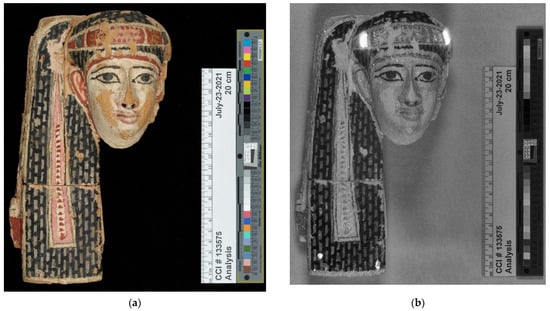
Figure 5.
(a) Overall VIS image of the sculpture; (b) overall VIL image of the sculpture. The areas of Egyptian blue are much brighter than the surrounding areas and approach white in tonality.
The high resolution of the overall focus-stacked VIL image allowed details from centimeter-sized areas of the sculpture to be examined. This allowed for clear interpretation, especially when correlating the VIL results to regions of the object viewed directly under the microscope. This permitted the mapping of individual, sub-millimeter (~30–70 μm) grains of Egyptian blue. As shown in the examples below, the location of Egyptian blue particles in the VIL image details could be correlated with photomicrographs of the sculpture.
As shown in Figure 5, strong luminescence was observed in the blue colour areas on both temples, corresponding to the locations where Egyptian blue was identified by ER-FTIR spectroscopy. In addition, two small spots were observed, near the base of the figure’s headpiece at lower left. Close examination of the object under the microscope showed that these two small luminescing areas did indeed contain coarse blue pigment particles—possibly accidental drips of paint, based on the shape and appearance of the areas. One of these areas is shown in Figure 6. When this area is examined under high magnification, coarse blue particles are clearly visible.
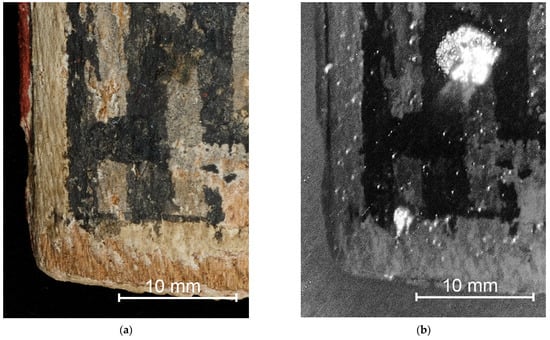
Figure 6.
(a) Detail from the VIS image of the object, near the base of the figure’s headpiece at lower left, (b) Corresponding detail from the VIL image of the object, showing a localized region of luminescence. This luminescent region corresponds to a concentration of coarse blue pigment particles, which are visible at high magnification, though not clearly visible in the VIS image.
In fact, there were also small specks of luminescence across the entire object, which was unanticipated. These specks were scattered across the red, yellow and white painted areas, but seemed less present in the black areas and were absent in the ground layer and on the bare wood. The Egyptian blue particles seem to be incorporated within the paint layers, and not part of an underlayer or surface coating. This can be seen for example, across the skin in Figure 7. These tiny areas of luminescence could often be correlated to individual coarse blue particles of Egyptian blue, when the object was examined under the microscope, as shown in Figure 8.
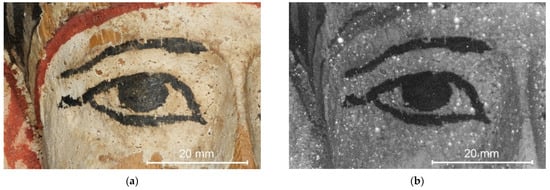
Figure 7.
(a) Detail from the VIS image of the object, showing the proper right eye; (b) corresponding detail from the VIL image of the object, showing discrete specks of luminescence across the skin, but absent from the black painted details of the eye.
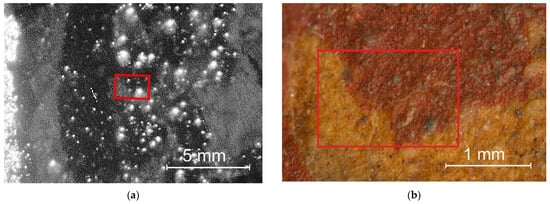
Figure 8.
(a) Detail from the VIL image taken from a red and yellow area. A cluster of four luminescent particles is encircled. (b) Photomicrograph of the red and yellow region at higher magnification. The same four particles have been encircled. This image was captured on a Leica 205C microscope using LAS X software and the Z-stacking function.
The reason for the presence of small amounts of Egyptian blue across the object is unclear, though it is interesting to note that the traces of pigment appear only in the paint layers and not in the ground layer. The amount of pigment is so small that its inclusion could be accidental—unintentional mixing on a palette, or with a dirty brush, for instance; however, its inclusion may also be the result of intentional mixing to create a more varied colour palette. Mixtures of small quantities of Egyptian blue with other pigments to create variations in tone, such as more life-like flesh-tones, have been previously reported [25,26,27].
4. Discussion
Two non-invasive methods, ER-FTIR spectroscopy and VIL photography, provided information about the composition and distribution of pigments on the fragmentary Egyptian sculpture.
There are several factors that complicate the interpretation of ER-FTIR spectra. The combination of diffuse and specular reflectance creates spectra with overlapping absorption bands, rehstrahlen bands, and derivative features, and combination and overtone bands which are greatly enhanced, limiting the usefulness of existing spectral reference libraries. The variability of analysis depth also complicates interpretation, as it becomes ambiguous as to which components are present in the layer of interest. Despite these limitations, calcite, gypsum, kaolin, quartz and Egyptian blue were identified on the sculpture using ER-FTIR spectroscopy without the need for any sampling or contact with the object.
Due to a number of constraints, the analytical scope of this particular study was limited to ER-FTIR spectroscopy and illustrated the strengths and limitations of this method for the identification of Egyptian pigments. The identification of pigments on the sculpture was not comprehensive, as some common Egyptian pigments, including orpiment, cannot be identified using this technique. We were also unable to confirm the binding medium of the polychromy using ER-FTIR spectroscopy. While the presence of other pigments, such as iron oxides, could be tentatively identified by colour in combination with the presence of common accessory minerals such as kaolin and quartz, a multi-technique approach combining ER-FTIR with other methods, such as XRF and Raman would provide a more definitive identification.
The distribution of the Egyptian blue on the fragmentary head was mapped using visible-induced infrared luminescence. As expected, the luminescent areas correspond to the areas in which Egyptian blue was identified by ER-FTIR spectroscopy. Applying VIL imaging with a high-resolution focus stacking process proved fruitful in mapping particles of Egyptian blue pigment on the surface of the fragmentary head. In combination with photomicroscopy, this allowed for the identification of individual, sub-millimeter size Egyptian blue particles.
The VIL image capture process described in previous publications [25,26,35] was improved in the present study by incorporating high-resolution focus stacking. The thickness and 3-dimensional features of the fragmentary head were problematic and without the use of focus stacking, small details of the image would be obscured by limited depth of field or lens diffraction. The amalgamation of focus stacking and VIL is a novel process and is applicable to many topographical and fully 3-dimensional objects containing Egyptian blue, or other pigments, such as cadmium sulfides, that exhibit infrared luminescence.
Despite obtaining very useful results, there is considerable room for further optimizing the VIL method used in this study. The reduction in image noise, specifically noise that is caused by high ISO and long shutter speeds, could be achieved. Experimenting with brighter LED panels or filtered flash could eliminate the need for higher ISO settings and would allow increased shutter speeds. An additional area for development would be the generation of a Lens Cast Calibration (LCC) for the VIL images. This would reduce vignetting and dramatically improve the VIL images. Although generating an LCC would be difficult due to the low emission levels of the VIL, increasing the intensity of the VIL light source could allow for sufficient IR radiation to pass through the LCC plate. An alternative solution may be to illuminate the subject with an IR source in a similar spectral range as the VIL emission, generate the LCC, and then apply it to the VIL images.
5. Conclusions
Applying an optimized VIL imaging method with a high-resolution focus stacking process allowed imaging of sub-millimeter particles of Egyptian blue pigment on the surface of the fragmentary head. With further refinement, the process could produce VIL images of even better quality for similar projects in the future. This IR imaging technique was complemented by ER-FTIR spectroscopy, the use of which allowed identification of Egyptian blue, as well as other common pigments, including calcite and gypsum. Future work on this object could include combining ER-FTIR results with other non-invasive methods, such as Raman spectroscopy and X-ray fluorescence (XRF), to expand the scope of materials identified.
Supplementary Materials
The following supporting information can be downloaded at: https://www.mdpi.com/article/10.3390/heritage6020056/s1. Figure S1: Egyptian blue transmission spectra; a packaged dataset of Raw ER-FTIR spectra is available in JCAMP-DX format.
Author Contributions
Conceptualization, S.B. and G.W.; investigation, S.B., G.W. and K.H.; writing—original draft preparation, G.W. and S.B.; writing—review and editing, K.H.; visualization, G.W.; All authors have read and agreed to the published version of the manuscript.
Funding
This research received no external funding.
Data Availability Statement
The raw spectral data associated with this study are available as supplementary material in JCAMP-DX format.
Acknowledgments
We acknowledge the Canadian Museum of History, and in particular Susannah Warren, Manager, Conservation and Preservation, Collections, for providing access to the object for study, and organizing its loan to CCI.
Conflicts of Interest
The authors declare no conflict of interest.
References
- Warren, S.; (Canadian Museum of History, Gatineau, QC, Canada). Personal communication, 2022.
- Rosi, F.; Burnstock, A.; Van den Berg, K.J.; Miliani, C.; Brunetti, B.G.; Sgamellotti, A. A Non-Invasive XRF Study Supported by Multivariate Statistical Analysis and Reflectance FTIR to Assess the Composition of Modern Painting Materials. Spectrochim. Acta Part A 2009, 71, 1655–1662. [Google Scholar] [CrossRef]
- Miliani, C.; Rosi, F.; Brunetti, B.G.; Sgamellotti, A. In situ noninvasive study of artworks: The MOLAB multitechnique approach. Acc. Chem. Res. 2010, 43, 728–738. [Google Scholar] [CrossRef] [PubMed]
- Brunetti, B.; Miliani, C.; Rosi, F.; Doherty, B.; Monico, L.; Romani, A.; Sgamellotti, A. Non-Invasive Investigations of Paintings by Portable Instrumentation: The MOLAB Experience. Top. Curr. Chem. 2016, 374, 10. [Google Scholar] [CrossRef] [PubMed]
- Nevin, A.; Doherty, T. The Noninvasive Analysis of Painted Surfaces: Scientific Impact and Conservation Practice; Smithsonian Institution Scholarly Press: Washington, DC, USA, 2016. [Google Scholar]
- Giorgi, L.; Nevin, A.; Nodari, L.; Comelli, D.; Alberti, R.; Gironda, M.; Mosca, S.; Zendri, E.; Piccolo, M.; Izzo, F.C. In-Situ Technical Study of Modern Paintings Part 1: The Evolution of Artistic Materials and Painting Techniques in Ten Paintings from 1889 to 1940 by Alessandro Milesi (1856–1945). Spectrochim. Acta Part A 2019, 219, 530–538. [Google Scholar] [CrossRef]
- Williams, R.S. On-site non-destructive MID-IR spectroscopy of plastics in museum objects using a portable FTIR spectrometer with fiber optic probe. MRS Online Proc. Lib. 1996, 462, 25–30. [Google Scholar] [CrossRef]
- Doherty, B.; Daveri, A.; Clementi, C.; Romani, S.; Bioletti, S.; Brunetti, B.; Sgamelloti, A.; Miliani, C. The Book of Kells: A non-invasive MOLAB investigation by complementary spectroscopic techniques. Spectrochim. Acta Part A 2013, 115, 330–336. [Google Scholar] [CrossRef] [PubMed]
- Buti, D.; Rosi, F.; Brunetti, B.G.; Miliani, C. In-situ identification of copper-based green pigments on paintings and manuscripts by reflection FTIR. Anal. Bioanal. Chem. 2013, 205, 2699–2711. [Google Scholar] [CrossRef] [PubMed]
- Saviello, D.; Toniolo, L.; Goidanich, S.; Casadio, F. Non-invasive identification of plastic materials in museum collections with portable FTIR reflectance spectroscopy: Reference database and practical applications. Microchem. J. 2016, 124, 868–877. [Google Scholar] [CrossRef]
- Bell, J.; Nell, P.; Stuart, B. Non-invasive identification of polymers in cultural heritage collections: Evaluation, optimisation and application of portable FTIR (ATR and external reflectance) spectroscopy to three-dimensional polymer-based objects. Herit. Sci. 2019, 7, 95. [Google Scholar] [CrossRef]
- Invernizzi, C.; Rovetta, T.; Licchelli, M.; Malagodi, M. Mid and near-infrared reflection spectral database of natural organic materials in the cultural heritage field. Int. J. Anal. Chem. 2018, 2018, 7823248. [Google Scholar] [CrossRef]
- Rosi, F.; Daveri, A.; Doherty, B.; Nazzareni, S.; Brunnetti, B.G.; Sgamellotti, A.; Miliani, C. On the use of overtone and combination bands for the analysis of the CaSO4-H2O system by mid-infrared reflection spectroscopy. Appl. Microsc. 2010, 64, 956–963. [Google Scholar] [CrossRef] [PubMed]
- Miliani, C.; Rosi, F.; Daveri, A.; Brunetti, B.G. Reflection infrared spectroscopy for the non-invasive in situ study of artists’ pigments. Appl. Phys. A 2012, 106, 295–307. [Google Scholar] [CrossRef]
- Lee, L.; Quirke, S. Painting Materials. In Ancient Egyptian Materials and Technology; Nicholson, P.T., Shaw, I., Eds.; Cambridge University Press: Cambridge, MA, USA, 2000; pp. 104–120. [Google Scholar]
- Colinart, S. Analysis of Inorganic Yellow Colour in Ancient Egyptian Painting. In Colour and Painting in Ancient Egypt; Davies, W.V., Ed.; The British Museum Press: London, UK, 2001; pp. 1–4. [Google Scholar]
- Scott, D.A. A review of ancient Egyptian pigments and cosmetics. Stud. Conserv. 2016, 61, 185–202. [Google Scholar] [CrossRef]
- Siddall, R. Mineral pigments in archaeology: Their analysis and the range of available materials. Minerals 2018, 8, 201. [Google Scholar] [CrossRef]
- Riederer, J. Egyptian Blue. In Artists’ Pigments: A Handbook of Their History and Characteristics; West FitzHugh, E., Ed.; National Gallery of Art: Washington, DC, USA, 1997; Volume 3, pp. 183–202. [Google Scholar]
- Hatton, G.D.; Shortland, A.J.; Tite, M.S. The production technology of Egyptian blue and green frits from the Second millenium BC Egypt and Mesopotamia. J. Archaeol. Sci. 2008, 35, 1591–1604. [Google Scholar] [CrossRef]
- Nicola, M.; Seymour, M.M.; Aceto, M.; Priola, E.; Gobetto, R.; Masic, A. Late production of Egyptian blue: Synthesis from brass and its characteristics. Archaeol. Anthropol. Sci. 2019, 11, 5377–5392. [Google Scholar] [CrossRef]
- Ajò, D.; Chiari, D.; De Zuane, F.; Favaro, M.L.; Bertolini, M. Photoluminescence of some blue natural pigments and related synthetic materials. In Proceedings of the Art’96 5th International Conference on Non-destructive Testing, Microanalytical Methods and Environmental Evaluation for Study and Conservation of Works of Art, Budapest, Hugary, 14 June 1996; pp. 33–46. [Google Scholar]
- Pozza, G.; Ajò, D.; Chiari, D.; De Zuane, F.; Favaro, M. Photoluminescence of the inorganic pigments Egyptian blue, Han blue and Han purple. J. Cult. Herit. 2000, 1, 393–398. [Google Scholar] [CrossRef]
- Accorsi, G.; Verri, G.; Bolognesi, M.; Armaroli, N.; Clementi, C.; Miliani, C.; Romani, A. The exceptional near-infrared luminescence properties of cuprorivaite (Egyptian blue). Chem. Commun. 2009, 23, 3392–3394. [Google Scholar] [CrossRef]
- Verri, G. The spatially resolved characterization of Egyptian blue, Han blue and Han purple by photo-induced luminescence digital imaging. Anal. Bioanal. Chem. 2009, 394, 1011–1021. [Google Scholar] [CrossRef]
- Verri, G. The application of visible-induced luminescence imaging to the examination of museum objects. SPIE Proc. 2009, 7391. [Google Scholar] [CrossRef]
- Verri, G.; Saunders, D.; Ambers, J.; Sweek, T. Digital mapping of Egyptian blue: Conservation implications. Stud. Conserv. 2010, 55 (Suppl. S2), 220–224. [Google Scholar] [CrossRef]
- Linn, R.; Cline, E.H.; Yasur-Landau, A. The advantages of visible induced luminescence technique for the investigation of Aegean-style wall painting: A case study from Tel Kabri, Israel. In Tracing Technoscapes. The Production of Bronze Age Wall Paintings in the Eastern Mediterranean; Becker, J., Jungfleisch, J., von Rüden, C., Eds.; Sidestone Press: Leiden, The Netherlands, 2017; pp. 101–116. [Google Scholar]
- Kakoulli, I.; Radpour, R.; Lin, Y.; Svoboda, M.; Fischer, C. Application of forensic photography for the detection and mapping of Egyptian blue and madder lake in Hellenistic polychrome terracottas based on their photophysical properties. Dyes Pigm. 2017, 136, 104–115. [Google Scholar] [CrossRef]
- Dyer, J.; Sotiropoulou, S. A technical step forward in the integration of visible-induced luminescence imaging methods for the study of ancient polychromy. Herit. Sci. 2017, 5, 24. [Google Scholar] [CrossRef]
- Abdrabou, A.; Abdalla, M.; Islam, A.; Shaheen, I.A.; Kamal, H.M. Investigation of an Ancient Egyptian polychrome wooden statuette by imaging and spectroscopy. Int. J. Conserv. Sci. 2018, 9, 39–54. Available online: https://ijcs.ro/public/IJCS-18-04_Abdrabou.pdf.
- Abdrabou, A.; Abdallah, M.; Sultan, G.; Mostafa, M.; Bayoumi, H.; Magdy, R.; Abd El Kader, M.; Hamza, N.; Mamdouh, D.; Elsayed, H.; et al. Tutankhamun’s polychrome wooden shawabtis: Preliminary investigation for pigments and gilding characterization and indirect dating of previous restorations by the combined use of imaging and spectroscopic techniques. Open Archaeol. 2022, 8, 30–54. [Google Scholar] [CrossRef]
- Masic, A.; Nicola, M. NIR Luminescence and composition of Egyptian blue as markers in archaeometric evaluations. Microsc. Microanal. 2021, 27, 3004–3006. [Google Scholar] [CrossRef]
- Seymour, L.M.; Nicola, M.; Kessler, M.I.; Yost, C.L.; Bazzacco, A.; Marello, A.; Ferraris, E.; Gobetto, R.; Masic, A. On the production of ancient Egyptian blue: Multi-modal characterization and micron-scale luminescence mapping. PLoS ONE. 2020, 15, e0242549. [Google Scholar] [CrossRef]
- Hedeaard, S.B.; Brøns, C.; Drug, I.; Saulins, P.; Bercu, C.; Jakovlev, A.; Kjær, L. Multispectral Photogrammetry: 3D models highlighting traces of paint on ancient sculptures. In CEUR Workshop Proceedings 2364, Proceedings of the Digital Humanities in the Nordic Countries 4th Conference, Copenhagen, Denmark, 5–8 March 2019; Navarretta, C., Agirrezabal, M., Maegaard, B., Eds.; University of Copenhagen: Copenhagen, Denmark, 2019; Volume 17, pp. 181–189. Available online: https://ceur-ws.org/Vol-2364/17_paper.pdf (accessed on 10 January 2023).
- Frey, F.; Heller, D.; Kushel, D.; Vitale., G. The AIC Guide to Digital Photography and Conservation Documentation, 2nd ed.; Warda, J., Ed.; American Institute for Conservation: Washington, DC, USA, 2011; pp. 130–148. [Google Scholar]
- Wiseman, G.; (Canadian Conservation Institute, Ottawa, ON, Canada); Tse, S.; (Canadian Conservation Institute, Ottawa, ON, Canada). Effectiveness of LED & CuSO4 Filtered Flash for Visible-Induced Infrared Luminescence Imaging. (CCI# 130665). 2018; (Unpublished internal report). [Google Scholar]
- Heywood, A. The Use of Huntite as a White Pigment in Ancient Egypt. In Colour and Painting in Ancient Egypt; Davies, W.V., Ed.; The British Museum Press: London, UK, 2001; pp. 5–9. [Google Scholar]
- Barnes, S.S.; (Canadian Conservation Institute, Ottawa, ON, Canada); Helwig, K.; (Canadian Conservation Institute, Ottawa, ON, Canada). Non-invasive FTIR and Raman spectroscopy of select Egyptian objects, (CCI# 132665, CSD# 5719). 2022; (Unpublished internal report). [Google Scholar]
- Straus Center for Conservation, Harvard University Art Museums. IMP0005, Egyptian blue, PB31; Price, B.A., Pretzel, B., Lomax, S., Eds.; Infrared and Raman Users Group Spectral Database; Infrared and Raman Users Group, 2007. [Google Scholar]
- Philadelphia Museum of Art. IMP00090, Egyptian Blue, PB31; Price, B.A., Pretzel, B., Lomax, S., Eds.; Infrared and Raman Users Group Spectral Database; Infrared and Raman Users Group, 2007. [Google Scholar]
- Philadelphia Museum of Art. IMP00100, Pompei Bleu; Price, B.A., Pretzel, B., Lomax, S., Eds.; Infrared and Raman Users Group Spectral Database; Infrared and Raman Users Group, 2007. [Google Scholar]
Disclaimer/Publisher’s Note: The statements, opinions and data contained in all publications are solely those of the individual author(s) and contributor(s) and not of MDPI and/or the editor(s). MDPI and/or the editor(s) disclaim responsibility for any injury to people or property resulting from any ideas, methods, instructions or products referred to in the content. |
© 2023 Government of Canada, Canadian Conservation Institute. Submitted for possible open access publication under the terms and conditions of the Creative Commons Attribution (CC BY) license (https://creativecommons.org/licenses/by/4.0/).